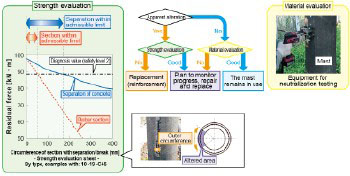10.Proposal of method for diagnosing health of concrete masts for maintenance
Concrete masts (hereafter ‘masts’) have been in mainstream use on the railways for over 50 years, and there is a need to determine what criteria and grounds should be used, in terms of degradation, to decide when to replace these masts.
To this end, the state of health of 500 masts was surveyed along a stretch of commercial line, including bending strength tests and materials analyses. Results showed that the main process generating mast damage was ‘crack precedence’ i.e. the appearance of cracks followed by deterioration of the construction material, for example rebar corrosion in the cracked areas.
Based on this deterioration process, a method was proposed for diagnosing the health of masts, for maintenance (Fig. 1).
The diagnosis is made in several steps, starting with the existing visual inspection of masts. When there is no apparent alteration, a ‘materials evaluation’ is conducted, whereas a ‘strength evaluation’ is made if alteration is observed.
The materials evaluation carried out when no apparent alteration is observed involves testing for neutralization of the concrete surface, which is a typical sign of concrete deterioration. The progress of neutralization in masts is significantly slower than on civil structures, therefore thorough testing is required with testing of the surface to a depth of 1 mm.
In the case of strength tests conducted when apparent alteration has been observed, a ‘strength evaluation sheet’ was designed showing the correlation between bending strength and external circumference of the mast, making on-site diagnosis possible by checking whether the mast meets level 2 safety requirements contained in the regulations for railway technical standards.
If the external circumference of the mast is within the admissible limits, then the mast can remain in place, otherwise, it is marked as needing to be replaced.
Other Contents
- 1. Advanced seismograph for earthquake early warnings
- 2.Method for extracting vulnerable structures during earthquakes
- 3.Seismic reinforcement technology for earth retaining walls in narrow locations
- 4. Method for assessing tsunami damage to concrete bridges
- 5. Management of snowmelt for landslide prevention
- 6. Calculation of the aerodynamic coefficient on trains in half-bank half-cut line sections
- 7. Revision of evaluation criteria to check deterioration in lubricating grease used on trains
- 8.Method for detecting step-shaped wear on contact strips on pantograph heads
- 9.Improving lightening resistance of electrical equipment using new grounding structure
- 10.Proposal of method for diagnosing health of concrete masts for maintenance
- 11.On-board platform detection device to assist train crew in train door operation
- 12.Human factor analysis method using Potential Incidents Reports
- 1. Advanced seismograph for earthquake early warnings
- 2.Method for extracting vulnerable structures during earthquakes
- 3.Seismic reinforcement technology for earth retaining walls in narrow locations
- 4. Method for assessing tsunami damage to concrete bridges
- 5. Management of snowmelt for landslide prevention
- 6. Calculation of the aerodynamic coefficient on trains in half-bank half-cut line sections
- 7. Revision of evaluation criteria to check deterioration in lubricating grease used on trains
- 8.Method for detecting step-shaped wear on contact strips on pantograph heads
- 9.Improving lightening resistance of electrical equipment using new grounding structure
- 10.Proposal of method for diagnosing health of concrete masts for maintenance
- 11.On-board platform detection device to assist train crew in train door operation
- 12.Human factor analysis method using Potential Incidents Reports

